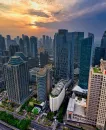How green building practices enhance urban office productivity
Daylighting, fresh air, and efficient design boost health and productivity.
Despite campaigns emphasising sustainable development and green strategies to enhance office building performance by reducing resource consumption, many urban offices overlook basic practices like planting, which offer significant benefits for health and productivity.
Engr. Ronald Cadapan, Manager for Office Services - Landlord Representation at Colliers Philippines, said that there are a lot of factors when it comes to enhancing health and productivity in offices.
He emphasised that tenants have control over choosing the quality of their workplace environment. "For busy urban offices, part of what we call the built environment strategies revolve around emulating elements of a natural environment, such as daylighting and providing fresh air for improved air quality."
Cadapan explained that adequate lighting can reduce eye strain, and good quality views near windows can improve mood. Additionally, outdoor air, which is often less polluted than indoor air recirculated within a building, can significantly enhance air quality. "Other strategies that allow for an optimal user experience include noise control, excellent acoustics, achieving thermal comfort, and ergonomic design," he added.
The choice of plants in urban office buildings also impacts maintenance costs and water use. "There are varied water demands for each plant species, which are attributed to their specific growth factors, size, and maintenance requirements," Cadapan noted. Developers can reduce operational costs by adopting water recycling strategies, such as onsite treatment from rainwater and greywater sources, supported by efficient watering systems like drip irrigation or smart irrigation using soil moisture sensors.
Non-conventional plant choices, such as hydroponic plants that grow in water instead of soil and drought-tolerant plants requiring minimal irrigation, can also contribute to cost savings. "I’ve seen buildings get certified while easily achieving a 30% reduction for landscape irrigation and possibly more by consolidating these design strategies," Cadapan remarked.
However, enforcing mandatory green building codes presents several challenges, particularly cost. "For a developing country such as the Philippines, green buildings usually have about a 10 to 20% cost premium over conventional buildings regarding construction costs."
This premium depends on the target level of certification or compliance, as some sustainable products are of higher quality and may not be locally available. Developers are often hesitant to absorb additional upfront costs for green building design because the cost savings benefit future owners and tenants, who pay the utility bills.



















 Advertise
Advertise




